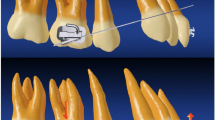Summary
This study evaluated, over a 4-month study period, the amount of apical root resorption occurring in maxillary central incisors following their retraction when employing either micro-implant or J-hook headgear anchorage. The prospective randomised clinical trial was conducted in Orthodontic Clinic, College of Stomatology, China from 2008–2009. Subjects are patients requiring fixed appliances on waiting list (n=20). In female Han Chinese patients aged from 16–26 years, standardized periapical radiographs from 10 randomly assigned patients with maxillary protrusions comprising the micro-implant group, and from 10 similar patients comprising the J-hook headgear group, were assessed for maxillary central incisor apical root resorption. Measurements before and after orthodontic therapy were also obtained from lateral cephalometric radiographs to calculate incisor horizontal retraction and vertical intrusion distances. Estimated retraction force vectors were calculated in horizontal and vertical directions for both treatment groups. Data analysis employed t-tests and the Pearson correlation test, with α=0.05 for statistical significance. The results showed that when compared with the J-hook group, significantly more apical root resorption shortening of the maxillary central incisors was observed in the micro-implant group (1.27 mm difference, 95% CI=0.70–1.84, P<0.001), which was associated with a significantly larger retraction distance (P=0.004) and a smaller vertical force component (P<0.0001). We are led to conclude that continuous activation of the nickel-titanium coil springs used in the micro-implant group resulted in significantly more apical root resorption shortening and maxillary central incisor retraction than when intermittent J-hook retraction was employed. The employment of continuous duration orthodontic forces presents a risk for increased apical root resorption that requires careful radiographic monitoring.
Similar content being viewed by others
References
Pizzo G, Licata ME, Guiglia R, et al. Root resorption and orthodontic treatment. Review of the literature. Minerva Stomatologica, 2007,56(1–2):31–44
Lopatiene K, Dumbravaite A. Risk factors of root resorption after orthodontic treatment. Stomatologija, 2008,10(3):89–95
Faltin RM, Faltin K, Sander FG, et al. Ultrastructure of cementum and periodontal ligament after continuous intrusion in humans: a transmission electron microscopy study. Eur J Orthod, 2001,23(1):35–49
Levander E, Malmgren O. Long-term follow-up of maxillary incisors with severe apical root resorption. Eur J Orthod, 2000,22(1):85–92
Chen WJ, Li QY, Gong AX, et al. Comparison between J-hook and micro-implant anchorage in the treatment of patients with bimaxillary protrusion. Zhonghua Kouqiang Yixue Zazhi (Chinese), 2008,43(2):83–86
Ma J, Wang L, Zhang W, et al. Comparative evaluation of micro-implant and headgear anchorage used with a pre-adjusted appliance system. Eur J Orthod, 2008,30(3):283–287
Park HS, Yoon DY, Park CS, et al. Treatment effects and anchorage potential of sliding mechanics with titanium screws compared with the Tweed-Merrifield technique. Am J Orthod Dentofacial Orthop, 2008,133(4):593–600
Deguchi T, Murakami T, Kuroda S, et al. Comparison of the intrusion effects on the maxillary incisors between implant anchorage and J-hook headgear. Am J Orthod Dentofacial Orthop, 2008,133(5):654–660
Park HS. An anatomical study using CT images for the implantation of micro-implants. Korean J Orthod, 2002, 32(6):435–441
Sameshima GT, Sinclair PM. Predicting and preventing root resorption: Part I. Diagnostic factors. Am J Orthod Dentofacial Orthop, 2001,119(5):505–510
Owman-Moll P. Orthodontic tooth movement and root resorption with special reference to force magnitude and duration. A clinical and histological investigation in adolescents. Swedish Dent J Suppl, 1995,105:1–45
Jiang RP, Zhang D, Fu MK. A factors study of root resorption after orthodontic treatment. Zhonghua Kouqiang Yixue Zazhi (Chinese), 2003,38(6):455–457
Mirabella AD, Årtun J. Risk factors for apical root resorption of maxillary anterior teeth in adult orthodontic patients. Am J Orthod Dentofacial Orthop, 1995,108(1):48–55
Linge BO, Linge L. Apical root resorption in upper anterior teeth. Eur J Orthod, 1983,5(3):173–183
Baumrind S, Korn EL, Boyd RL. Apical root resorption in orthodontically treated adults. Am J Orthod Dentofacial Orthop, 1996,110(3):311–320
Lin Y, Zhong PP, Zhang DQ. Investigation of the possible factors related to root resorption during orthodontic treat ment in adolescents. Shanghai Kouqiang Yixue, 2007,16(1):24–27
Marques LS, Ramos-Jorge ML, Rey AC, et al. Severe root resorption in orthodontic patients treated with the edgewise method: prevalence and predictive factors. Am J Orthod Dentofacial Orthop, 2010,137(3):384–388
Rupp R. Root resorption related to orthodontics and other factors: a review of the literature. J Gen Orthod, 1995,6(3):25–29
Årtun J, Smale I, Behbehani F, et al. Apical root resorption six and 12 months after initiation of fixed orthodontic appliance therapy. Angle Orthod, 2005,75(6):919–926
Smale I, Årtun J, Behbehani F, et al. Apical root resorption 6 months after initiation of fixed orthodontic appliance therapy. Am J Orthod Dentofacial Orthop, 2005,128:57–67
Sameshima GT, Sinclair PM. Predicting and preventing root resorption: Part II. Treatment factors. Am J Orthod Dentofacial Orthop, 2001,119(5):511–515
Hujoel P, Hollender L, Bollen AM, et al. Radiographs associated with one episode of orthodontic therapy. J Dent Edu, 2006,70(10):1061–1065
Mavragani M, Vergari A, Selliseth NJ, et al. A radiographic comparison of apical root resorption after orthodontic treatment with a standard edgewise and a straight-wire edgewise technique. Eur J Orthod, 2000,22(6):665–674
Mohandesan H, Ravanmehr H, Valaei N. A radiographic analysis of external apical root resorption of maxillary incisors during active orthodontic treatment. Eur J Orthod, 2007,29(2):134–139
Harry MR, Sims MR. Root resorption in bicuspid intrusion: a scanning election microscope study. Angle Orthod, 1982,52(3):235–258
Costopoulos G, Nanda R. An evaluation of root resorption incident to orthodontic intrusion. Am J Orthod Dentofacial Orthop, 1996,109(5):543–548
Stuteville OH. Injuries caused by orthodontic forces and the ultimate results of these injuries. Am J Orthod Oral Surg, 1938,24:103–116
Aras B, Cheng LL, Turk T, et al. Physical properties of root cementum: part 23. Effects of 2 or 3 weekly reactivated continuous or intermittent orthodontic forces on root resorption and tooth movement: a microcomputed tomography study. Am J Orthod Dentofacial Orthop, 2012, 141(2):29–37
Author information
Authors and Affiliations
Corresponding author
Additional information
This project was supported by the Priority Academic Program Development of Jiangsu Higher Education Institutions.
Rights and permissions
About this article
Cite this article
Wang, Q., Chen, W., Smales, R.J. et al. Apical root resorption in maxillary incisors when employing micro-implant and J-hook headgear anchorage: A 4-month radiographic study. J. Huazhong Univ. Sci. Technol. [Med. Sci.] 32, 767–773 (2012). https://doi.org/10.1007/s11596-012-1032-4
Received:
Published:
Issue Date:
DOI: https://doi.org/10.1007/s11596-012-1032-4




